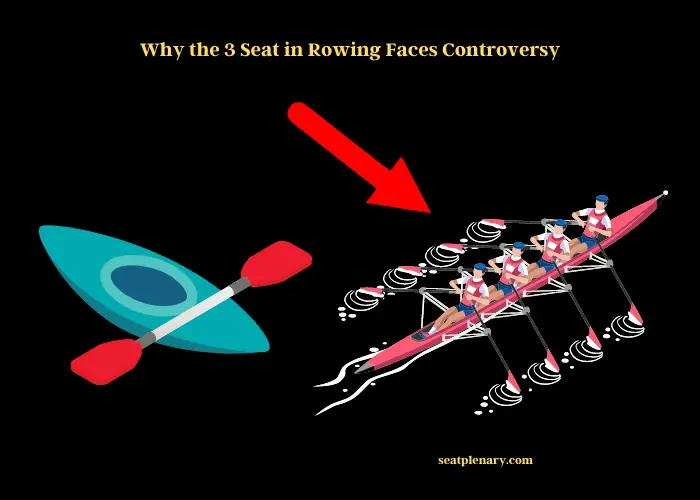Three seat in rowing is often considered the spot where a rower has the least impact on the boat’s balance. This is mainly because the middle of the boat is wider and more stable. So, if you were to put a technically weaker rower in this position, it might not affect the boat’s balance as much as other seats would.
Imbalance in a rowing boat can mess up everything. Imagine trying to maintain rhythm when the boat’s swaying side to side. Even if three seat is more forgiving, it’s still pivotal for synchronization. Think about it: if you’re offbeat even for a split second, the entire team feels it. It affects the boat’s momentum and the smooth coordination of the rowers. Good technique is essential no matter where you’re seated.

Next comes power distribution. A boat gains speed and maintains efficiency when every rower contributes equally. If the rower in three seat isn’t up to par, it can cause issues. The ergonomics of rowing demands each rower complements the other. So, even if three seat can somewhat hide a less experienced rower, it’s always better for the entire crew if every rower is in sync and at their best.
Rowing is all about stability and rhythm. It’s a dance on water where everyone needs to move in perfect harmony. Now that you’ve got the basics, why not continue and read the detailed article below to dive deeper into the world of rowing?
Why the 3 Seat in Rowing Faces Controversy
Ever wondered about the ins and outs of rowing, especially the debate swirling around the 3 seat? Let’s get into it!
The Basics of Boat Balance in Rowing
Rowing isn’t just about strength; it’s a blend of science and art. Every move a rower makes affects the balance of the boat. The boat’s stability isn’t just the responsibility of one person—it’s a collective effort. So, what’s the big fuss with individual seats?
Understanding the physics behind rowing
Imagine a seesaw. If both sides aren’t equally balanced, it doesn’t work, right? Rowing works on a similar principle. Each rower’s movement needs to complement the others, ensuring a smooth journey through the water.
How individual seats influence the boat’s stability
Picture this: A finely tuned orchestra with each musician playing a unique role. In rowing, each seat contributes to the overall performance, with some having more influence over balance and others less so.
The Anatomy of a Rowing Boat
Rowing boats are marvels of design. The positioning of each seat is strategic, ensuring optimal performance.
Components and structure of a typical rowing boat
Rowing boats come with a variety of sections: the bow, stern, and, of course, the seats. Each section plays its part in ensuring the boat moves swiftly and smoothly.
| Seat Number | Role in Boat | Impact on Balance |
| 1 (Bow) | Leads the boat | Moderate |
| 2 | Adds speed | High |
| 3 | Central position | Low |
| 4 | Adds power | High |
| 5 (Stern) | Steers the boat | Moderate |
The Unique Nature of the 3 Seat
This seat has stirred quite the debate among rowing enthusiasts. But why?
Its location in the boat and why it matters
The 3 seat is like the middle child in a family. It’s sandwiched between powerful rowers, which sometimes leads to it being overshadowed. Its central location offers more stability, but is that always a good thing?
Comparing the 3 seat’s impact to other positions
Imagine being in a dance troupe where one member doesn’t quite match the energy of the rest. That’s what some argue about the 3 seat. But is this fair? Let’s see.
Synchronization & Power Distribution Challenges
Rowing is a rhythm game. If one rower misses a beat, it can throw off the entire boat.
The importance of rhythm in rowing
Have you ever tried dancing out of beat? Doesn’t feel right, huh? Rowing without rhythm is similar—it’s just not as effective or graceful.
How the 3 seat can disrupt the boat’s momentum
The 3 seat might be in a stable position, but if it’s not in harmony with the rest, it can disrupt the flow. Think of it as that one out-of-tune instrument in a band. Sounds jarring, doesn’t it?
Ergonomics and the Rowing Process
Ever tried sitting in an uncomfortable chair for hours? Ergonomics is crucial in rowing just like in that scenario.
| Seat Number | Comfort Level | Adjustability | Impact on Rowing Technique |
| 1 (Bow) | High | Low | Significant |
| 2 | Moderate | Moderate | High |
| 3 | Low | High | Minimal |
| 4 | Moderate | Low | High |
| 5 (Stern) | High | Low | Significant |
The specific ergonomics of the 3 seat and its effects
The 3 seat’s design sometimes makes it challenging for rowers. It’s like trying to write with a pen that doesn’t quite fit your hand—it’s doable, but not ideal.
The Role of Technique in Rowing
Imagine trying to paint without the right brush strokes. In rowing, technique is that brush stroke—it makes all the difference.
Basic techniques every rower should know
Good posture, synchronized strokes, and effective breathing are fundamental. But what happens if one of these is off, especially in the debated 3 seat?
How technique can be compromised in the 3 seat
While the 3 seat offers stability, it can sometimes be a crutch. It’s like having training wheels on a bike—you’re stable, but are you really mastering the skill?
Real-Life Testimonies: Rowers Speak Out
Who better to hear from than the rowers themselves? Their experiences shine a light on this topic like no other.
Personal experiences from professional rowers
Many rowers feel that the 3 seat is unique, offering challenges and opportunities. It’s like being given a tricky role in a play—some actors might struggle, while others shine.
The pros and cons they’ve observed with the 3 seat
Like any debate, there are two sides to every story. Some rowers believe the 3 seat is underrated, while others feel it’s rightly criticized. Who’s right?
Solutions & Alternatives to the 3 Seat Dilemma
Facing a problem without seeking solutions is like sailing without a compass. So, what are the potential fixes for the 3 seat controversy?
Potential changes to boat design
Could a redesign be the key? Like tweaking a recipe to perfection, maybe adjusting the boat’s design could address the 3 seat concerns.
Training adjustments for the 3 seat rower
Perhaps it’s not about the seat but the training. What if specialized training routines could bring out the best in 3 seat rowers?
The Broader Impact of Seat Assignments
Choosing seats isn’t random. It’s strategic, much like choosing players in a football team based on their strengths.
How seat selection affects team dynamics
Assigning seats can be as intricate as solving a jigsaw puzzle. Each piece, or in this case, rower, has a specific place and role. But what happens if one piece doesn’t quite fit?
Strategies coaches use for optimal seat placements
Coaches often have their work cut out for them. It’s a balancing act—matching rowers to seats while ensuring team harmony and peak performance.
Historical Context: Has the 3 Seat Always Been Problematic?
History offers lessons, and the rowing world is no exception. So, has the 3 seat always been under scrutiny?
A brief history of rowing seat assignments

Rowing has evolved over the years, and so have seat assignments. The emphasis on specific seats, like our controversial 3 seat, has seen shifts over time.
| Time Period | Preferred Seats | Less Favored Seats | Reason |
| 1900s-1950s | 1, 5 | 3 | Stability concerns |
| 1960s-1980s | 2, 4 | 3 | Technique adjustments |
| 1990s-Now | 1, 2, 4, 5 | 3 | Ergonomics & balance |
Perspectives from Other Water Sports
Rowing isn’t the only water sport with unique challenges. By looking at other disciplines, maybe we can glean some insights.
Comparing rowing with other team-based water sports
Dragon boat racing, canoeing, kayaking—each has its intricacies. How do their challenges stack up against rowing, especially concerning seat assignments?
Lessons rowing can learn from these disciplines
Sometimes, a fresh perspective offers the best solutions. Can rowing borrow some strategies from other water sports to address the 3 seat debate?
Summary
So, why is the 3 seat bad in rowing? Well, it’s not as black and white as it seems. It has its challenges, sure. But with tweaks in design, training, and approach, maybe the 3 seat can find its rhythm. After all, isn’t adaptation the name of the game?
You might also enjoy:
- 5 Best Seat Covers for Chevy Colorado in 2023
- What is Evotex Seating? GM’s Revolutionary Upholstery Explained
- Fixing the Issue: One Side of Power Seat Won’t Move in Your Car
- Your Essential Guide on Quad Seats: History, Types, and Selection
- Can You Paint a Toilet Seat? A Complete Guide to DIY Success
